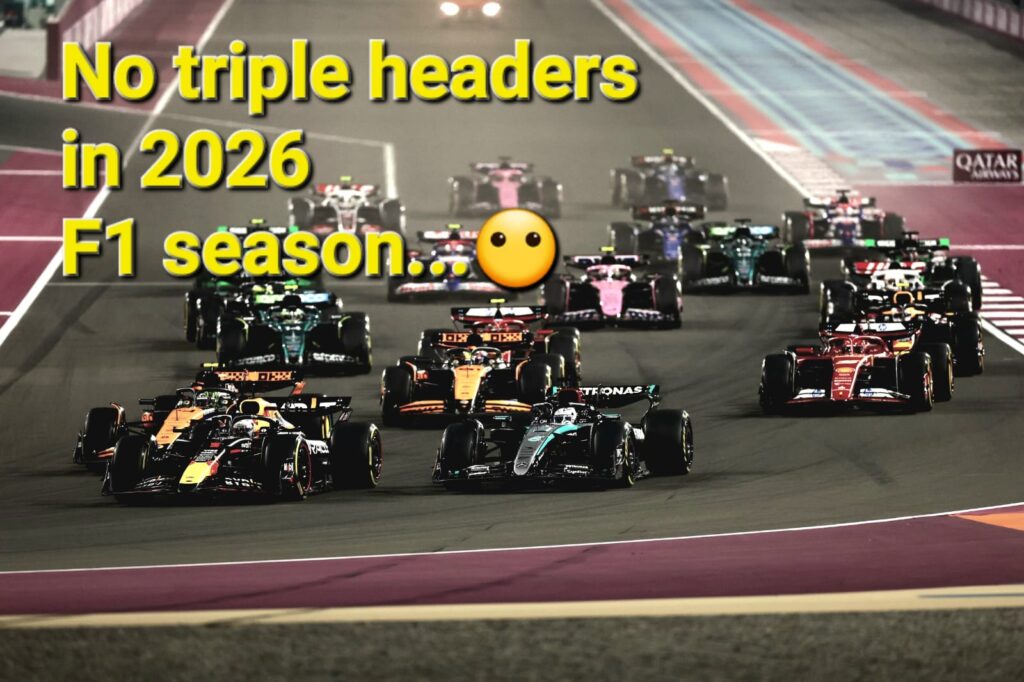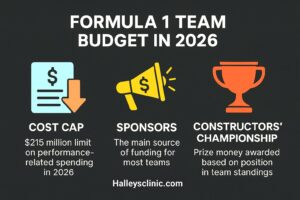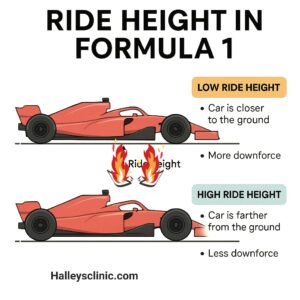Why Are There No Triple Headers in the 2026 F1 Season? Full Race Calendar Revealed

- By Dr. AK Rana
F1 fans won’t be thrilled to learn that there’ll be no triple headers in 2026. Those back-to-back Sundays felt like magic—a three-week adrenaline rush we all waited for.
Welcoming a calendar without them feels like letting go of a ritual we secretly adored.
But let’s not forget the toll it took on teams and drivers, who lived through the chaos and fatigue of three intense weeks.
Still, with 7 double headers lined up, there’s plenty of action to cheer for.
Not a bad trade-off, just a more balanced one.
Definition of a Triple Header:
Three consecutive race weekends, without a weekend break between them.
🏁 2026 Formula 1 Race Calendar (Confirmed)
- March
- March 6–8 – Australian GP (Melbourne)
- 🇨🇳 March 13–15 – Chinese GP (Shanghai)
- April
- 🇯🇵 March 27–29 – Japanese GP (Suzuka)
- 🇧🇭 April 10–12 – Bahrain GP (Sakhir)
- 🇸🇦 April 17–19 – Saudi Arabian GP (Jeddah)
- May
- 🇺🇸 May 1–3 – Miami GP (USA)
- 🇮🇹 May 15–17 – Emilia Romagna GP (Imola)
- 🇲🇨 May 22–24 – Monaco GP (Monte Carlo)
- June
- 🇪🇸 June 12–14 – Spanish GP (Barcelona)
- 🇦🇹 June 26–28 – Austrian GP (Spielberg)
- July
- 🇬🇧 July 3–5 – British GP (Silverstone)
- 🇧🇪 July 17–19 – Belgian GP (Spa)
- 🇭🇺 July 24–26 – Hungarian GP (Budapest)
- August
- 🌍 Summer Break (No races)
- September
- 🇳🇱 August 21–23 – Dutch GP (Zandvoort)
- 🇮🇹 September 4–6 – Italian GP (Monza)
- 🇪🇸 September 11–13 – Madrid GP (New Spanish GP debut)
- 🇦🇿 September 25–27 – Azerbaijan GP (Baku)
- October
- 🇸🇬 October 9–11 – Singapore GP (Marina Bay)
- 🇺🇸 October 23–25 – US GP (Austin)
- 🇲🇽 October 30 – Nov 1 – Mexican GP (Mexico City)
- November
- 🇧🇷 November 6–8 – Brazilian GP (Interlagos)
- 🇺🇸 November 19–21 – Las Vegas GP (Night Race)
- 🇶🇦 November 27–29 – Qatar GP (Lusail)
- December
- 🇦🇪 December 4–6 – Abu Dhabi GP (Yas Marina)
As you can see,
…
There are no triple headers on the 2026 calendar as per the official schedule and are replaced by 7 double headers.
There are 7 double headers in the 2026 Formula 1 calendar:
1. Australia – China (March)
2. Bahrain – Saudi Arabia (April)
3. Monaco – Spain (June)
4. Belgium – Hungary (July)
5. Mexico – Brazil (Oct–Nov)
6. Las Vegas – Qatar (November)
7. Qatar – Abu Dhabi (Nov–Dec)
…
Pros of Triple Headers
1. Sustained Fan Engagement
Continuous race weekends keep fans excited and involved.
Media coverage, predictions, and discussions stay hot for three weeks straight.
2. Commercial Momentum
Great for broadcasters, sponsors, and social media traction.
3. Logistics Efficiency (Sometimes)
If races are geographically close, it can reduce travel time/cost compared to spreading them out.
…
Cons of Triple Headers
1. Team & Staff Fatigue
Back-to-back-to-back race weekends are physically and mentally exhausting.
Mechanics, engineers, drivers, and support staff get minimal rest.
Travel, jet lag, and long hours make burnout a real issue.
2. Logistical Strain
Transporting cars, equipment, and staff between countries quickly is complex and costly.
Customs, freight, and unpredictable weather delays can cause chaos.
3. Reduced Development Time
Teams struggle to bring upgrades or fix issues between races.
No time for simulator work or factory feedback.
4. Decreased Race Quality
Fatigue and rushed preparations can lead to mistakes—on and off track.
Less time to regroup or change strategy after a bad weekend.
5. Less Local Hype for Each Race
Triple headers can dilute excitement, especially for mid-races.
Each race might feel less special if it’s part of a packed schedule.
With new regulations to come in 2026, along with two new teams and more drivers to join the grid, along with internal team changes; this list will go on, a lot is going to change in 2026 and we are ever ready to join the hustle!
Drop your thoughts in the comments
Stay tuned with Halleysclinic.com
📧 Contact: halleysclinic@gmail.com
Don’t forget to follow our Instagram account https://www.instagram.com/halleysclinic





